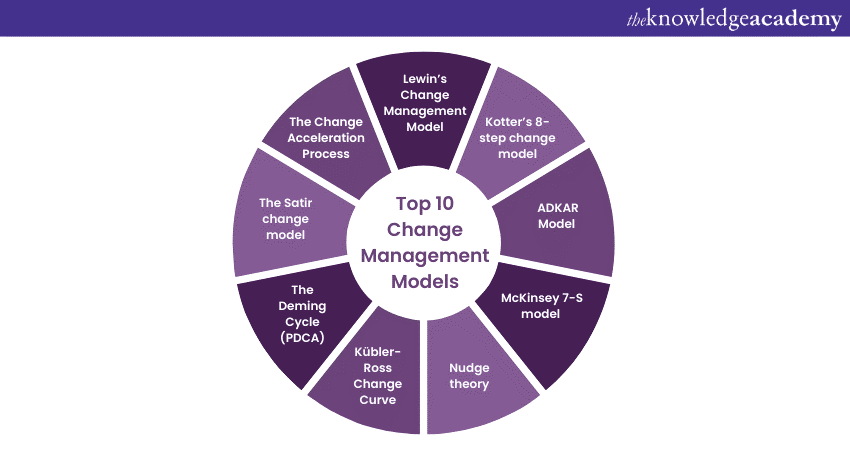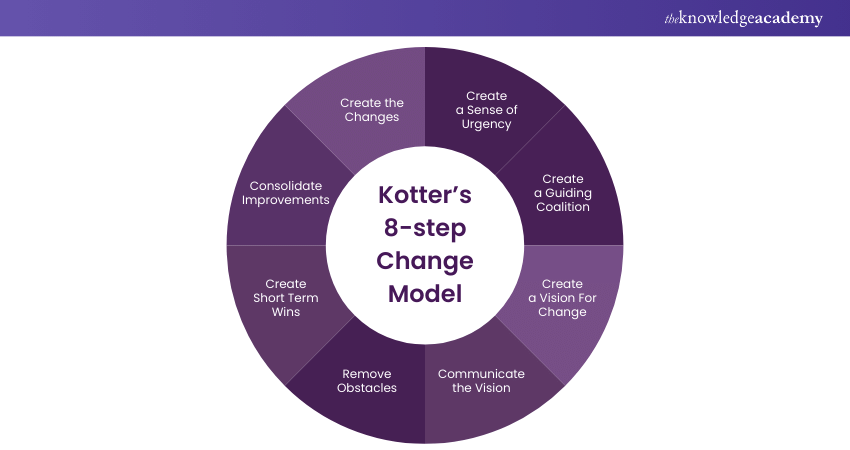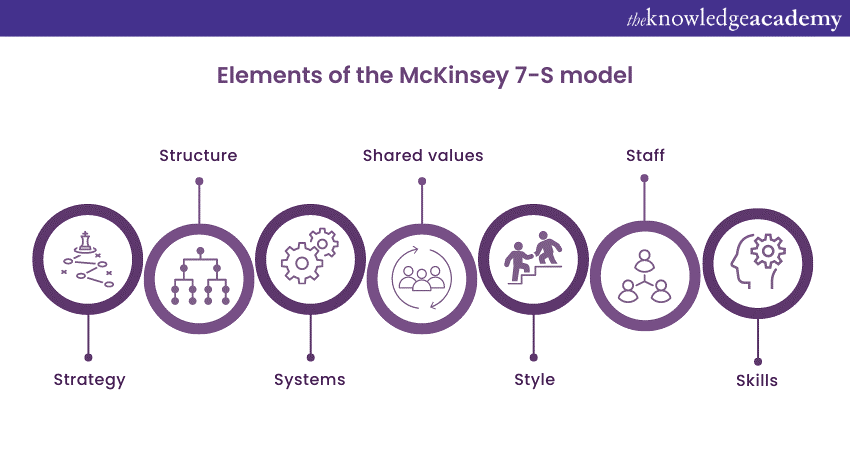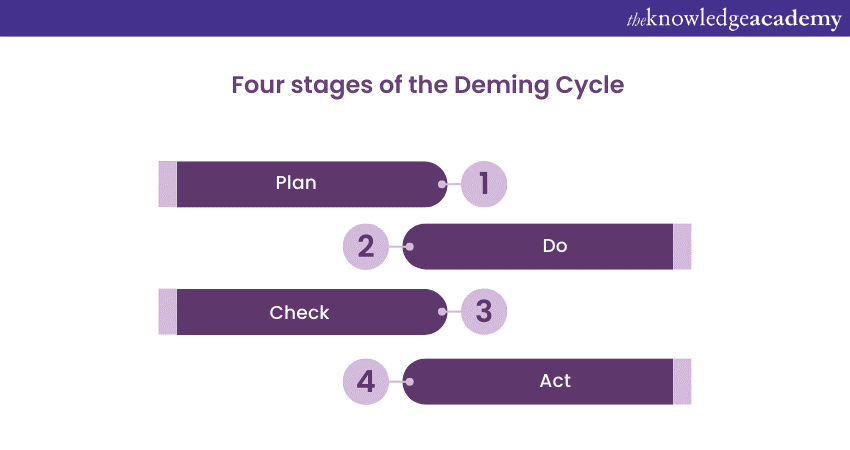We may not have the course you’re looking for. If you enquire or give us a call on 01344203999 and speak to our training experts, we may still be able to help with your training requirements.
Training Outcomes Within Your Budget!
We ensure quality, budget-alignment, and timely delivery by our expert instructors.

Change Management has become a necessity in almost all organisations today, owing to the fast-paced business environment and their susceptibility to change. However, navigating the complexities of organisational change can be a daunting task, which is why they require a systematic approach and Change Management Models.
Enterprises can avail of multiple Change Management Models for their smooth functioning and easy transition to change. These Models provide a structured framework and set of principles that guide organisations through the process of initiating, implementing, and managing change.
This blog showcases a comprehensive list of the best Change Management Models used by organisations to adapt, evolve, and remain competitive in today’s ever-changing landscape. So, if your organisation is planning to implement change, it is time to learn about these Models and drive success. Delve in to learn more!
Table of Contents
1) What is a Change Management Model?
2) What are the best Change Management Models in 2024?
3) Why are Change Models important?
4) Key components of a good Change Management Model
5) Conclusion
What is a Change Management Model?
Change Management Model is a methodology that offers detailed guidance when it comes to organisational change. Be it anything from planned transitions to transformations, this Model provides a structured approach to navigating them. It also helps navigate any challenges that arise during this process. Moreover, it makes sure that these changes are successfully adopted and implemented.
There is not just one, but many Change Management Models that provide a detailed roadmap for understanding these changes for everyone in the organisation. Overall, it makes it easier for everyone to implement these changes as well as enforce these transitions as the new practice.
What are the best Change Management Models?
Change Management Models encompass the best practices and strategies that aim to simplify the change implementation process in organisations. Let’s look at a list of the best Change Management Models that can help you and your business:

1) Lewin’s Change Management Model
Lewin’s Model is one of the earliest models to be introduced for simplifying Change Management. It is one of the most used Change Management Tools in various industries. It provides a three-stage framework that helps organisations understand and navigate the change process. The three stages are known as unfreezing, changing, and refreezing. Let’s look at these stages in detail:
a) Unfreeze: It refers to the act of ‘unfreezing’ the existing mindset and beliefs of the employees of an organisation to prepare them for change.
By highlighting the gap between the current state and the desired future state, unfreezing helps overcome resistance to change and motivates individuals to embrace new possibilities, simplifying Change Management.
b) Change: The second stage refers to the actual implementation of change. The processes involved in this stage can include restructuring, introducing new technologies, modifying roles and responsibilities, or altering organisational culture.
c) Refreeze: The final stage of Lewin's model is refreezing, which involves anchoring the changes into the organisation's culture, processes, and behaviours. It aims to make the new state the norm, ensure the changes become permanent and sustainable, and guarantee quality Change Management.
2) Kotter’s 8-step Change Model

Kotter's 8-Step Change Model was developed by renowned Change Management expert John Kotter. This Change Management Model outlines a step-by-step approach that helps organisations navigate the complexities of change effectively and increase the likelihood of successful implementation. Let's explore each step in detail:
a) Create a sense of urgency: This stage is essential in effective Change Management. Leaders must communicate the reasons behind the need for change, highlighting the possible risks involved in maintaining the status quo and the opportunities that change can bring to motivate employees and overcome resistance.
b) Form a powerful coalition: Leaders need to build a strong team or coalition of influential individuals who support the change. This coalition should have diverse skills, expertise, and influence to guide the change effort and drive it forward.
c) Develop vision and strategy: A clear and inspiring vision for the future is crucial in guiding the change effort. Leaders must develop a compelling vision that outlines the desired state after implementing the change.
d) Communicate the vision: Leaders must consistently and transparently communicate the reasons for change and the vision, alongside the benefits it will bring to individuals and the organisation. Open communication helps in building trust and reduces uncertainty during the change process.
e) Empower your employees: To facilitate change leading to effective Change Management, leaders need to empower employees by removing barriers and providing the necessary resources and authority to act.
f) Generate short-term wins: Creating and celebrating quick, visible wins is essential to maintain momentum and build confidence in the change process. Leaders should identify early opportunities for success and communicate and celebrate these achievements to motivate employees.
g) Maintain the momentum: After achieving early wins, it is crucial to build on the momentum and continue driving the change process. Leaders should leverage the credibility gained from initial successes to tackle larger challenges and implement changes for quality Change Management.
h) Anchor the changes: In the final step, leaders must ensure that the changes are embedded in the organisation's culture and become the new way of doing things. This involves aligning the enterprise's policies, procedures, and reward systems with the desired change.
3) ADKAR Model
The ADKAR Model, developed by Jeff Hiatt, is one of the most used Change Management Models focusing on individual transitions during change. It provides a structure for understanding the key elements necessary for successful change at the individual level. ADKAR stands for:
a) Awareness: The first stage in the ADKAR Model refers to creating awareness about the change. This includes understanding why change is necessary, what it entails, and its potential impact on individuals and the organisation.
b) Desire: The second stage of the Model focuses on growing an individual’s desire to support and participate in the change. Leaders must communicate the benefits and positive outcomes of the change, addressing any perceived disadvantages or uncertainties.
c) Knowledge: In this stage, individuals are required to acquire the necessary knowledge and information to implement the change effectively. This includes providing training, resources, and clear instructions on how to carry out new processes, tasks, or behaviours associated with the change.
d) Ability: The ability stage focuses on building the skills and capabilities required to perform new tasks or behaviours associated with the change. It involves providing individuals with the necessary support, coaching, and development opportunities to develop the skills needed for the change.
e) Reinforcement: The final stage of the ADKAR Model emphasises the importance of reinforcement to sustain the change. It involves creating a supportive environment reinforcing the new behaviours, processes, and systems the change introduces.
4) McKinsey 7-S Model
The McKinsey 7-S Model is a widely used Change Management framework for assessing and improving organisational effectiveness. Developed at McKinsey & Company by Tom Peters, Robert Waterman, and Julien Philips with the help from Richard Pascal and Anthony G. Athos this model focuses on seven interrelated elements that need to be aligned to achieve organisational success. Let's explore each element of the McKinsey 7-S Model in detail:

a) Strategy: Strategy represents an organisation's overall direction and plan for achieving its goals. It involves making choices about where to compete, how to differentiate, and how to create value.
b) Structure: Structure refers to the organisation's formal framework, including its hierarchy, reporting relationships, and division of responsibilities. It determines how people and functions are organised and how information flows within the organisation.
c) Systems: Systems encompass the processes, procedures, and routines that govern how work is done within the organisation. This includes Performance Management Systems, Information Systems, Financial Systems, and other operational processes.
d) Shared values: Shared values represent the fundamental beliefs and guiding principles that shape the organisation's culture. They define what the organisation stands for and influence employee behaviour and decision-making.
e) Style: Style encompasses the Leadership And Management practices within the organisation. It includes the values, behaviours, and norms exhibited by leaders and managers and their impact on the organisation's culture.
f) Staff: Staff refers to the organisation's human resources, including the number, skills, and deployment of employees. It involves recruiting, developing, and retaining talented individuals aligned with the organisation's strategy and culture.
g) Skills: Skills represent the capabilities and competencies of individuals and teams within the organisation. This includes technical skills, functional expertise, and other specialised knowledge required to perform tasks and achieve strategic objectives.
5) Bridges’ Transition Model
William Bridges developed Bridges' Transition Model, a Change Management Model that helps individuals and organisations navigate the emotional and psychological transitions that occur during change. This model recognises that change is not a one-time event but a process that requires individuals to go through three distinct stages, which are as follows:
a) Ending, losing, and letting go: The first stage of Bridges' Transition Model focuses on acknowledging and addressing the endings associated with change. During this stage in Change Management, individuals may experience a range of emotions, such as resistance, denial, sadness, or even anger. Leaders and change agents must provide support, communicate openly, and help individuals understand the need for change and help them in letting go of their anger and resistance.
b) Neutral zone: The neutral zone, also called the "limbo" or "in-between" stage, is a period of ambiguity and exploration between the ending and the new beginning. During this stage, individuals are no longer in the old state, and the new state has not yet fully materialised. Leaders should encourage experimentation, support, and foster a sense of psychological safety to help individuals adapt and explore new possibilities.
c) New beginning: The new beginning stage represents when individuals start to embrace and integrate the changes into their lives. It involves creating new routines, establishing new relationships, and developing a sense of stability and confidence in the new state.
6) Nudge theory
Nudge Theory is based on the understanding that biases, heuristics, and environmental factors often influence human decisions. It suggests that individuals can be nudged towards making better choices or adopting desired behaviours without the need for mandates or direct enforcement. The application of Nudge Theory spans various domains, including public policy, healthcare, finance, and marketing. The basic principles of the Theory include:
a) Defining the changes
b) Factoring in the employee’s perspective
c) Showcasing proof to determine the best options
d) Mentioning that the change is a choice
e) Considering employee feedback
f) Limiting options
g) Celebrating short-term wins to establish change
7) Kübler-Ross Change Curve
The Kübler-Ross Change Curve is another type of Change Management Model developed by Psychiatrist, Elisabeth Kübler-Ross. It explains the emotional journey individuals often experience when faced with significant change or loss.
Although originally applied to the process of grieving, the Model has also been widely used to understand and navigate the emotional response to organisational change. It explains the five stages that individuals go through when presented with a change. These stages include the following:
a) Denial: The first stage is characterised by denial and disbelief. Individuals may resist accepting the reality of the change and may try to maintain the status quo. They may downplay the significance of the change or ignore the signs that it is happening.
b) Anger: As the reality of the change sets in, individuals may experience anger and frustration. They may question why the change is happening, feel a sense of injustice, or direct their anger towards those responsible for implementing it. Anger can manifest as resistance.
c) Bargaining: In the bargaining stage, individuals may try to negotiate or find a way to minimise the impact of the change. They may seek compromises or make deals to regain some control or alleviate their fears and concerns.
d) Depression: Depression is a stage characterised by sadness, loss, and resignation. Individuals may feel overwhelmed by the magnitude of the change and its challenges.
e) Acceptance: The final stage of the Kübler-Ross Change Curve is acceptance. In this stage, individuals come to terms with the change and accept the new reality. They embrace the change, find ways to work within the new framework, and develop a sense of optimism for the future.
8) The Deming Cycle (PDCA)
The Deming Cycle, or the PDCA Cycle, is a continuous improvement model developed by renowned Statistician and Management Consultant Dr W. Edwards Deming. PDCA is an acronym for Plan, Do, Check, and Act, which are the four stages of the cycle aiming for effective Change Management. The four stages are as follows:

a) Plan: In this stage, organisations identify a problem or opportunity for improvement and develop a plan to address it. Planning includes gathering data, analysing the current state, setting targets, and creating a roadmap for implementation.
b) Do: This is the execution phase where organisations put the planned actions into practice. This may involve testing new processes, conducting pilot projects, or implementing changes on a small scale.
c) Check: The check stage evaluates and assesses the outcomes and data collected during the do stage. Organisations compare the actual results against the planned targets and analyse the data to determine if the desired improvements have been achieved.
d) Act: The act stage involves taking action based on the insights obtained from the check stage. It is about making adjustments, implementing corrective measures, and refining the processes to achieve better results. This stage may involve making changes to the original plan, revising targets, or refining the implementation strategy based on the feedback and analysis conducted in the previous stages.
9) The Satir Change Model
The Satir Change Model is a Change Management Model that explains the process individuals and systems go through when faced with change. Satir's Model also focuses on the emotional and psychological aspects of change and highlights the importance of communication, self-esteem, and unity in navigating change effectively. The Satir Change Model consists of the following five stages:
a) Late status quo: The first stage represents the current state or the status quo. It is the familiar and predictable state that individuals or systems are accustomed to right before the change is introduced.
b) Resistance: The resistance stage begins when the comfort provided by the prior stage ceases. The arrival of the change is represented as a foreign element, which could be an external event, a new idea, or an internal realisation that prompts the need for change.
c) Chaos: The chaos stage is a period of heightened uncertainty, confusion, and emotional turmoil. It is a transition stage where the old patterns and ways of functioning break down, and new possibilities emerge. Intense emotions, conflicts, and disorientation characterise the chaos stage.
d) Integration: This stage of the Satir Change Model represents the re-establishment of stability and the integration of the changes into the individual or system. In this stage, individuals or systems adapt to the new reality, develop new behaviour patterns, and achieve a renewed sense of balance and unity.
e) New status quo: This stage represents the acceptance of the change as it is now embedded in the organisation’s culture. It is no longer a new skill but of second nature to the employees.
10) Maurer 3 Levels of Resistance and Change Model
This Model is quite different from the other Change Management Models. In this Model, the primary focus is to identify the causes of the changes to fail. With the help of this Model, you can identify the critical levels of resistance. These levels include the following:
a) “I don’t get it”: People generally reject the changes because they don’t understand them. Therefore, it is important that the employees provide all the information to the employees.
b) “I don’t like it”: In the second level of resistance, “I don’t like it”, employees feel frustrated with the change. They tend to resist it because they are afraid that they will hit a roadblock at every step of the change and fail.
c) “I don’t like you”: In the third and final stage of the resistance, employees doubt the judgement and decisions of the organisation. Therefore, it is important that the management must inform and help the employees believe in the decision by showing them evidence of why they are making those decisions.
Become the catalyst for positive change in your organisation with our Change Management Foundation & Practitioner Course - join now!
Why Change Models are important?
Change Management Models offer comprehensive knowledge on implementing the best practices of Change Management in an organisation. So, understanding these models is extremely important for organisations. Principles of change management actually guide them towards a structured approach. It doesn't matter if you use just one or a blend of different approaches, these Models will improve the effectiveness of implementing new changes.
The Change Management process is a double-edged sword, and using it properly can lead to a lot of benefits. However, if used improperly, it can wreak devastating consequences as change projects are extremely complex and expensive. So, make sure to weigh in such risks in your change management process.
However, hope is on the horizon as these Models have the potential to offer great success and sustainable growth. You can also use proven and well-established models to increase the efficiency of your change initiatives. Following such established models has the following benefits:
1) Overcome resistance
2) Streamline communication
3) Smooth transitions
Key components of a good Change Management Model
There are some factors which make a Change Management Model become better. These factors are as follows:
a) Clarity in the purpose
b) Detailed planning
c) Good stakeholders' engagement
d) Flexibility
e) Adaptability
f) Involvement and participation of employees
g) Training
h) Development
i) Monitoring
j) Evaluation
k) Sustainability
Conclusion
Gaining an in-depth understanding of Change Management Models can help you implement Changes effectively and efficiently in your organisation. We hope the contents of this blog have successfully taken you through thebest Change Management Models you can use.
Ready to take your Change Management skills to the next level? Register for our Change Management Practitioner Course now!
Frequently Asked Questions

Here are seven Change Management Models:
a) McKinsey 7S Model
b) Bridges Transition Model
c) Nudge Theory
d) ADKAR Model
e) PDCA
f) LaMarsh Change Management Model
g) Kotter’s Eight-step Change Model

The five components of Change Management Models are as follows:
a) Vision
b) Skills
c) Incentive
d) Resource
e) Action plan

The Knowledge Academy takes global learning to new heights, offering over 30,000 online courses across 490+ locations in 220 countries. This expansive reach ensures accessibility and convenience for learners worldwide.
Alongside our diverse Online Course Catalogue, encompassing 17 major categories, we go the extra mile by providing a plethora of free educational Online Resources like News updates, Blogs, videos, webinars, and interview questions. Tailoring learning experiences further, professionals can maximise value with customisable Course Bundles of TKA.

The Knowledge Academy’s Knowledge Pass, a prepaid voucher, adds another layer of flexibility, allowing course bookings over a 12-month period. Join us on a journey where education knows no bounds.

The Knowledge Academy offers various Change Management Certification courses, including Change Management Foundation, Practitioner, and Risk Management for Change Training. These courses cater to different skill levels, providing comprehensive insights into Change Management skills.
Our Project Management blogs covers a range of topics related to Change Management, offering valuable resources, best practices, and industry insights. Whether you are a beginner or looking to advance your Change Management skills, The Knowledge Academy's diverse courses and informative blogs have you covered.
Upcoming Business Skills Resources Batches & Dates
Date
 Change Management Foundation & Practitioner
Change Management Foundation & Practitioner
Sat 11th May 2024, Sun 12th May 2024
Mon 13th May 2024
Mon 20th May 2024
Mon 3rd Jun 2024
Sat 8th Jun 2024, Sun 9th Jun 2024
Mon 17th Jun 2024
Mon 1st Jul 2024
Sat 6th Jul 2024, Sun 7th Jul 2024
Mon 15th Jul 2024
Mon 29th Jul 2024
Mon 12th Aug 2024
Sat 17th Aug 2024, Sun 18th Aug 2024
Tue 27th Aug 2024
Mon 9th Sep 2024
Sat 14th Sep 2024, Sun 15th Sep 2024
Mon 23rd Sep 2024
Mon 7th Oct 2024
Sat 12th Oct 2024, Sun 13th Oct 2024
Mon 21st Oct 2024
Mon 28th Oct 2024
Mon 4th Nov 2024
Sat 9th Nov 2024, Sun 10th Nov 2024
Mon 11th Nov 2024
Mon 18th Nov 2024
Mon 25th Nov 2024
Mon 2nd Dec 2024
Sat 7th Dec 2024, Sun 8th Dec 2024
Mon 9th Dec 2024
Mon 16th Dec 2024







 Top Rated Course
Top Rated Course



 If you wish to make any changes to your course, please
If you wish to make any changes to your course, please


